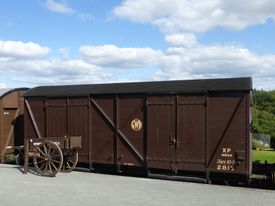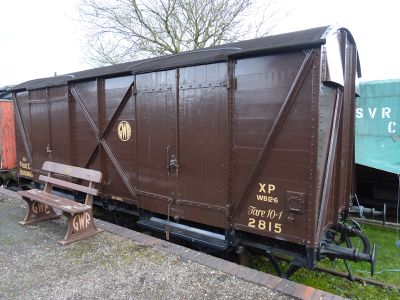GWR 2815 Fruit C Van
| GWR 2815 Fruit C Van | |
|---|---|
 GWR 2815 Fruit C Van | |
| Built By | GWR Swindon |
| Status | Static use |
| Number | 2815 |
| Other Numbers | W2815W, DW150343, 070843 |
| History | |
| Built | 1937 |
| Diagram | Y9 |
| Lot | 1606 |
| Type | 4-w ventilated van |
| Capacity | 10 tons |
| Telegraphic code | FRUIT C |
| Brakes | DCIII Dual braked |
| 2015 | Arrived on SVR |
Contents
Service and preservation
The GWR began building ventilated vans specifically to carry fruit in 1889, and an entire section of the wagon Diagram book (Diagram Y) was dedicated to them. Due to the perishable nature of the goods they carried, they became part of the 'Brown vehicle' series, being vacuum fitted for running in express passenger services as Non Passenger Carrying Coaching Stock rather than in slow unfitted goods trains. The letters 'XP' can be seen on the van, denoting this type of use.
As with other wagon types, there were a number of variants. The FRUIT C, originating with Diagram Y3 in 1911, had a 10-ton capacity with a length of 22ft over the headstocks. GWR 2424 is an example of this earlier Diagram. 2815 was built at Swindon in 1937 as carriage lot number 1606 to Diagram Y9.[note 1] The last GWR diagram to feature DCIII brakes, this was essentially an updated version of the 1911 design with end-bonnet vents, vertically planked doors and fewer side louvres. As a passenger fruit van It was fitted with gas lamps and removable galvanised wire trays.[1]
Under BR(W), 2815 became W2815W as part of the renumbering following nationalisation and the introduction of Mk1 carriage stock. It was subsequently transferred into Departmental stock as a CCE Equipment van, number DW150343, and eventually into Internal User stock as number 070843, serving as a CCE Stores Van[2][3].
Preservation
2815 was formerly at Rowden Mill station in Herefordshire, where it had been preserved since 1989.[4]
Back in 1967 Cadburys had donated four ex-Caledonian Railway covered goods vans to the SVR. Although some early use was made of them, they were not really appropriate to the railway and two had been scrapped as beyond repair during the 1970s. In mid-2015 the SVR received a proposal from the Ferryhill Railway Heritage Trust at Aberdeen to buy remaining two, 302080 and 304543, with a view to restoring them. The former was stored at Kidderminster Railway Museum awaiting restoration, but the latter had been in use for some time as an 'essential store' for the Hampton Loade Station Fund.
The deal was agreed, leaving the Station Fund in need of a new vehicle to act as their store. None of the Railway's wagons were available at that time, so 2815 was purchased from Rowden Mill on their behalf. Appearing in excellent condition as pictured below, it arrived at Kidderminster by road in November 2015 and moved to Hampton Loade in December 2015, in time for the Fund's stores to be transferred across before 304543 left for Scotland in March 2016.[5]
Since that time 2815 has remained in static use at Hampton Loade.
See also
- List of goods wagons
- GWR 3467 Fruit D Van (the vehicle used as Hampton Loade Station Fund shop)
Notes
- ↑ Generally carriages and wagons maintained their own series of Diagrams and Lot numbers. Although designed as a wagon, 2815 was ordered and numbered as if it were a carriage, being part of the 'brown vehicle' series.
References
- ↑ Atkins, Beard & Tourret (2013) pp. 36-37, 441-446.
- ↑ Longworth (2018) pp.170, 172,
- ↑ Departmentals.com (refers to the latter role as an RCE stores van)
- ↑ Railway Heritage Register Online
- ↑ SVR News 209
